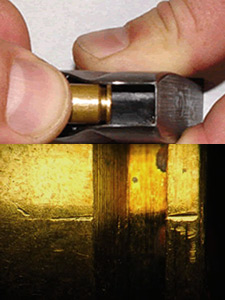- 01: Introduction
- 02: History
- 03: Propellants, Firearms, and Ammunition Development
- 04: Modern Firearms Manufacture
- 05: Small Arms Ammunition
- 06: Evidence Handling Procedures
- 07: Equipment and Instrumentation
- 08: Examination of Firearms
- 09: Cartridge and Shotshell Examination
- 10: Characterization and Evaluation of Fired Projectiles
- 11: Bullet Comparison and Identification
- 12: Gunshot Residue and Distance Determination
- 13: Toolmark Identification
- 14: Communicating Results
- Resources


Examination of Unfired Ammunition
Home > Cartridge and Shotshell Examination > Examination of Unfired Ammunition

Insertion into a magazine and
mark on brass cartridge
Examinations of unfired ammunition, both unfired cartridges and shotshells, proceed in much the same way as for fired cartridge cases and shotshell cases. The obvious difference is the absence of chamber or breech face marks, and the possible presence of a light strike(s) from a firing pin. Identifications can still be made on extractor, ejector, and magazine marks. These marks are valid toolmark identifications. However, the significance of these unique associations is different.
Based on these microscopic marks, it may be possible to state that unfired ammunition was
- loaded into and extracted from a particular firearm,
- loaded into and removed from a magazine integral to or associated with a given firearm.
The reasons for the cycling of ammunition through the action of a firearm (without firing) may include
- a decision to remove a cartridge from the chamber as part of the normal unloading process,
- an effort to clear a misfire,
- an effort to clear a misfeed,
- a criminal unconsciously leaving “courage marks” by repeatedly cycling ammunition through the action prior to the commission of a crime,
- other reasons best known to a criminal prior to the seizure of a firearm by law enforcement.
Even if an unfired cartridge or shotshell does not bear any microscopic marks of value for comparison purposes, an examiner can at least determine the types of firearms for which it is intended or with which it is compatible.




